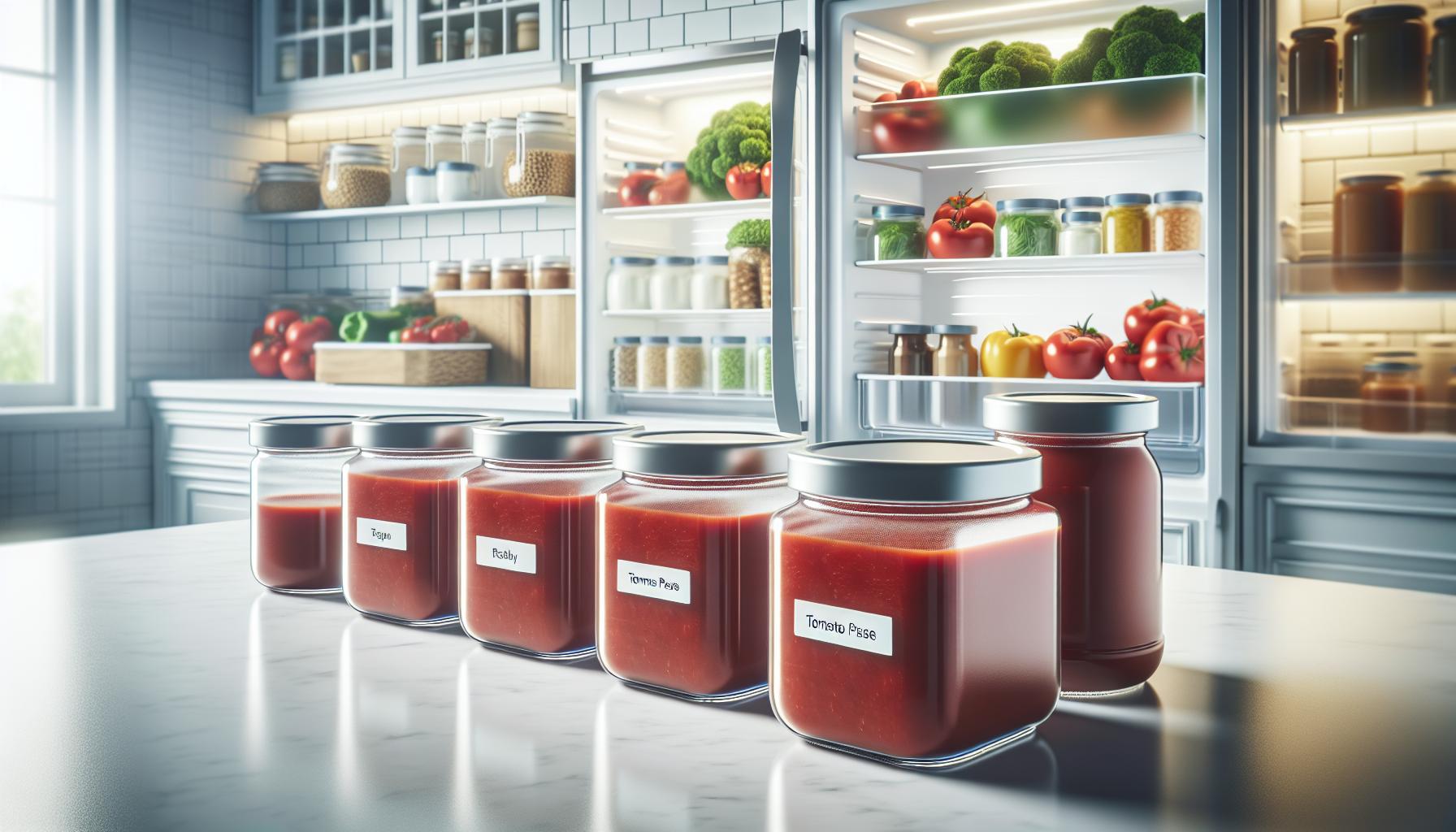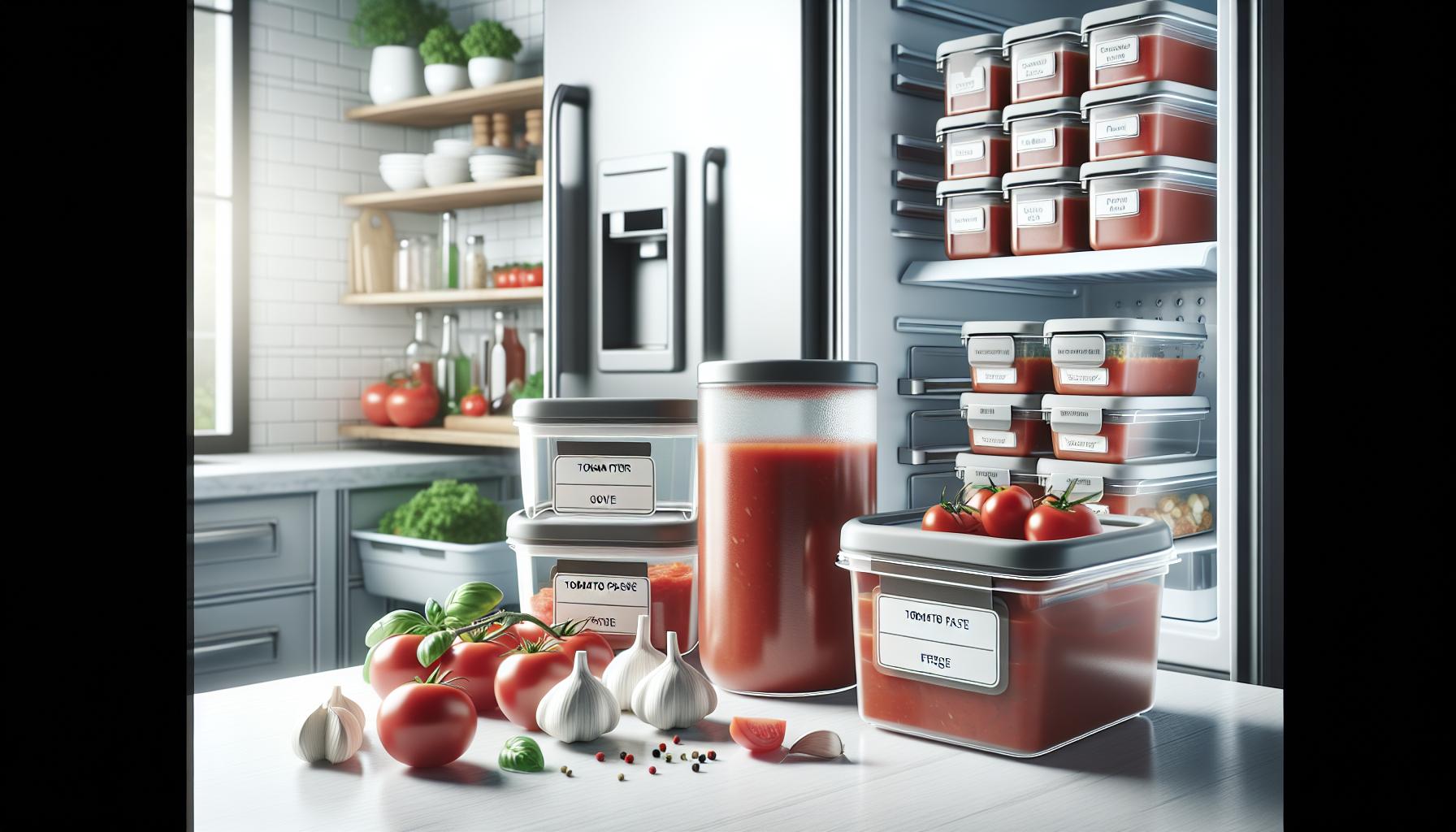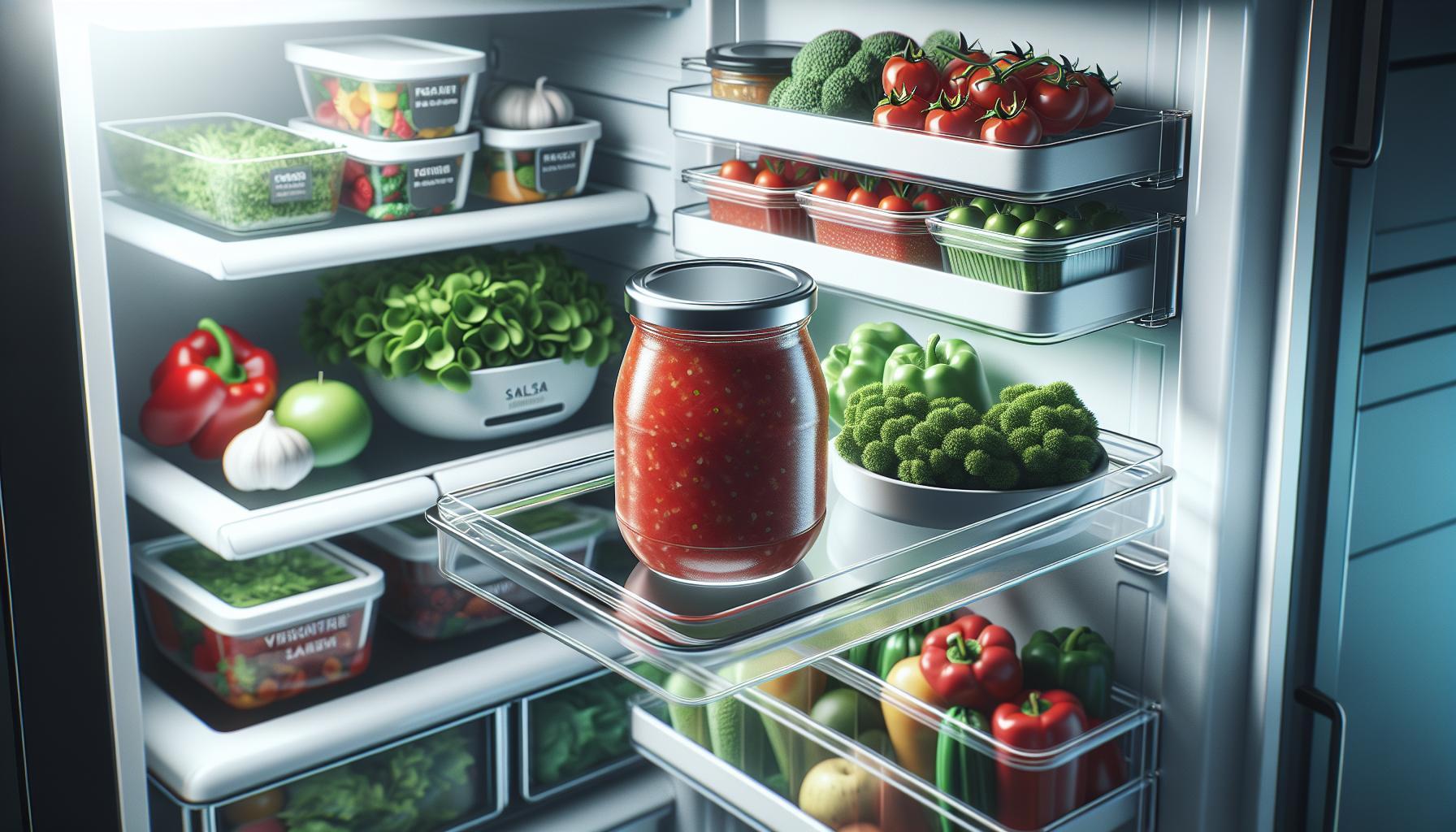Did you know that an opened can of tomato paste can last up to a week in the fridge? Tomato paste is a kitchen staple that adds depth and richness to countless dishes, but often, we find ourselves with leftover paste that we don’t want to waste. Knowing how long tomato paste lasts in the refrigerator not only helps you save money but also ensures you can enjoy its vibrant flavors without compromise.
In this article, we’ll explore the shelf life of tomato paste, providing practical storage tips and safety guidelines to keep your paste fresh and flavorful. Whether you’re looking to reduce food waste or simply make the most out of your cooking ingredients, understanding the right way to store tomato paste will elevate your culinary game. Read on to discover how to keep your tomato paste safe and delicious for your favorite recipes!
How Long Can You Store Tomato Paste in the Fridge?

Tomato paste is a versatile ingredient that enhances the flavor of many dishes, but once opened, knowing how long you can store it in the fridge is crucial for maintaining its quality. Typically, once you’ve opened a can or jar of tomato paste, it can be stored in the refrigerator for about 5 to 7 days. This timeframe ensures that you enjoy its rich flavors while keeping food safety in mind.
Proper storage is vital to prolong the paste’s lifespan. Always transfer leftover tomato paste into an airtight container rather than leaving it in its original packaging. This practice helps prevent exposure to air, which can lead to oxidation and spoilage. Additionally, be sure to keep your refrigerator temperature at or below 40°F (4°C) to ensure that food remains fresh and safe.
For those looking to extend the life of their tomato paste beyond a week, consider freezing it. Tomato paste can be portioned into ice cube trays and frozen, allowing you to use only what you need later on. This not only minimizes waste but also helps to preserve the vibrant flavor for future culinary adventures.
Signs Your Tomato Paste Has Gone Bad

Identifying when tomato paste has gone bad is crucial to ensure both flavor and safety in your cooking. The rich, concentrated essence of tomato paste is a staple in many recipes, but it is also susceptible to spoilage after opening. Awareness of the signs of spoilage can prevent unpleasant surprises and keep your dishes delicious.
One of the primary indicators that tomato paste has spoiled is a change in color. Fresh tomato paste is typically a deep red hue; however, if you notice it turning brown or developing any off-color patches, it’s a sign that oxidation has occurred, compromising its quality. Additionally, if you detect a sour or unusual odor emanating from the paste, it is best to err on the side of caution and discard it.
Texture also plays a significant role in assessing the safety of your tomato paste. If the paste has developed a watery layer on top (often referred to as “separation”), it may be a sign of spoilage, especially if this is accompanied by any foul smell. Furthermore, if you observe any mold growth-either on the surface or inside the container-this is an unmistakable sign that it should not be consumed.
In summary, always trust your senses when determining the state of your tomato paste. Regularly check for changes in color, odor, texture, and the presence of mold. Maintaining proper storage practices can significantly extend the shelf life of your ingredients, but vigilance is key for ensuring food safety and maximizing flavor.
Best Practices for Storing Tomato Paste
To maximize the longevity and flavor of your tomato paste, following best storage practices is essential. Tomato paste can last in the refrigerator for about 5 to 7 days once opened, but how you store it can make a significant difference in both taste and safety. One of the simplest yet most effective methods is to transfer any leftover paste into an airtight container. This minimizes exposure to air, thereby reducing the likelihood of oxidation and spoilage.
When storing tomato paste, consider portioning it into smaller amounts that align with your typical recipe needs. Using ice cube trays to freeze small quantities is particularly effective. Once frozen, you can transfer the cubes to a resealable bag, labeling it with the date and contents for easy identification. This allows you to use only what you need, preserving the rest for future culinary adventures.
For optimal results, ensure your refrigerator maintains a consistent cool temperature, ideally at or below 40°F (4°C). Additionally, keep the tomato paste away from the door, where temperature fluctuations are common due to frequent opening and closing.
Lastly, check the paste regularly and adhere to food safety guidelines. If you notice any signs of spoilage-such as changes in color, odor, or texture-it’s safest to discard the paste to prevent any foodborne illness. By implementing these best practices, you can enjoy your tomato paste’s vibrant flavor while minimizing waste.
Tips for Freezing Tomato Paste

When it comes to preserving your tomato paste, freezing is one of the most effective methods to extend its shelf life while maintaining flavor and quality. By utilizing your freezer, you can ensure that you have this versatile ingredient on hand for future culinary creations, avoiding waste and saving money.
One of the easiest ways to freeze tomato paste is by portioning it in small amounts. Ice cube trays are perfect for this purpose. Simply spoon the tomato paste into each compartment, filling them just enough so they can freeze evenly. Once frozen solid, transfer the cubes to a resealable plastic bag or an airtight container. Label the bag with the date and contents to make it easy to identify during future cooking sessions. Taking this step allows you to retrieve a practical serving size without defrosting an entire batch, making your cooking process smoother and more efficient.
For optimal freezing results, it’s crucial to ensure that the tomato paste is as air-free as possible before sealing it in its storage container. Consider using a vacuum sealer, which is ideal for removing air and preventing freezer burn, thereby extending the paste’s freshness. Frozen tomato paste can last for about 4 to 6 months in the freezer, but for best taste and quality, using it within 3 months is recommended. When you’re ready to use frozen tomato paste, simply remove the desired amount and let it thaw in the refrigerator or add it directly to your dish while cooking, as it will melt quickly.
By employing these freezing techniques, you’ll not only maximize the life of your tomato paste but also ensure that you always have this rich, concentrated flavor available whenever you need it. Embrace these methods, and you’ll never find yourself with leftover tomato paste going to waste again.
Using Leftover Tomato Paste Efficiently

can transform an ingredient that may otherwise go to waste into a valuable component of your cooking repertoire. Tomato paste is a concentrated form of tomatoes that packs a robust flavor, making it an excellent addition to a variety of dishes. Instead of leaving leftover paste languishing in the refrigerator, consider incorporating it into your favorite meals or storing it wisely for future use.
One effective method for using leftover tomato paste is to add it to sauces, soups, and stews. Just a tablespoon or two can enhance the depth of flavor, contributing both acidity and sweetness. It’s particularly great for enriching marinara sauce, chili, or a homemade tomato soup. Be mindful of the paste’s potency; start with small amounts and adjust to taste to avoid overpowering your dish. Additionally, mixing it into ground meats for meatballs or burgers can create a flavor profile that elevates your meal significantly.
For those who love to bake, leftover tomato paste can also play a role. Combine it with olive oil, herbs, and spices to make a flavorful pizza or pasta sauce. You can even blend it into bread dough or savory muffins to impart unique flavors. Other creative applications include adding it to marinades for meats or drizzling over vegetables before roasting for an added touch of richness.
If you find yourself with more leftover paste than you can use promptly, don’t fret. It can be frozen in small portions using ice cube trays, allowing you to access just what you need next time without defrosting an entire container. This approach not only conserves flavor but also reduces food waste significantly. When looking to reinvent your favorite recipes or try new ones, keeping tomato paste at your disposal is a smart culinary strategy.
Creative Recipes to Use Up Tomato Paste
Maximizing the utility of leftover tomato paste can elevate everyday meals while minimizing food waste. This thick and flavorful ingredient is a chef’s secret weapon, bursting with umami that can enhance a variety of dishes. By getting creative in the kitchen, you can ensure that your tomato paste is fully utilized rather than neglected at the back of the fridge.
One delightful way to use tomato paste is in a classic Bolognese sauce. Simply sauté chopped onions, garlic, and ground meat of your choice (beef, turkey, or even a meat substitute). Once browned, stir in a couple of tablespoons of tomato paste and let it caramelize slightly for a richer flavor before adding canned tomatoes, herbs, and seasonings. This concoction simmers to perfection and pairs beautifully with pasta, providing a comforting and hearty meal.
Another innovative application for tomato paste is in homemade salad dressings. Combine olive oil, balsamic vinegar, and a spoonful of tomato paste for a tangy vinaigrette that can elevate a simple salad. Season with salt, pepper, and fresh herbs like basil or oregano for an added depth of flavor. This easy dressing not only brings life to your greens but also utilizes your tomato paste in a fresh and healthy way.
For those looking to experiment, consider pizza or flatbread toppings. Spread tomato paste directly onto the crust as a base sauce, and then layer with your favorite ingredients, such as cheese, vegetables, and meats. This method not only infuses the dish with rich, concentrated tomato flavor but also allows you to craft a unique, customized pizza that makes the most of your pantry items.
Finally, you can use tomato paste in stews and soups. A tablespoon or two stirred into your simmering pot can transform ordinary vegetable or meat-based stews into robustly flavored dishes. It’s a quick way to add complexity to the taste without needing extra ingredients. Consider using it in a lentil soup or a chili, where it can mingle with broth and spices to create a filling, satisfying meal.
By employing these creative methods, you not only get to enjoy the rich flavor of tomato paste but also ensure that nothing goes to waste, aligning with sustainable cooking practices.
How to Revive Dried Out Tomato Paste
Reviving dried out tomato paste can be a simple yet effective way to minimize waste and ensure you get the most out of this versatile ingredient. If your tomato paste has hardened or developed a crusty layer, don’t fret; you can bring it back to a usable state with some straightforward methods.
One of the easiest ways to rejuvenate dried out tomato paste is by adding moisture. Place the dried paste in a small bowl and mix in a few teaspoons of water, broth, or even olive oil-just enough to create a spreadable consistency. Stir thoroughly until it becomes smooth and creamy again. If using heat for a quick fix, warm the paste gently in a saucepan over low heat, stirring constantly until it loosens.
Another technique involves blending. If your tomato paste has dried into a solid mass, consider transferring it to a food processor. Add a small amount of liquid (water or broth) and pulse until you achieve the desired consistency. This method not only revives the paste but also aerates it, which can improve the flavor melding when incorporated into dishes.
To prevent future drying, always store leftover tomato paste in an airtight container. For optimal preservation, add a thin layer of oil over the surface before sealing the container. This barrier slows moisture loss and helps keep the paste fresher for extended periods. If you know you won’t use the paste soon, consider freezing individual portions in ice cube trays for easy access later.
Using these methods, not only can you revive your dried tomato paste, but you can also enhance the culinary potential of your meals without the worry of waste. Keep these tips in mind next time you encounter a dried-out tub of tomato goodness!
Nutritional Value of Tomato Paste: What to Know
Tomato paste is not just a flavor enhancer but a powerhouse of nutrition, making it a valuable addition to your kitchen. It is concentrated from whole tomatoes and retains many of the beneficial properties of the fruit, offering a rich source of vitamins, minerals, and antioxidants. One of the standout components of tomato paste is lycopene, a potent antioxidant that has been associated with various health benefits, including reduced risk of chronic diseases like heart disease and certain cancers. This deep red pigment is more readily absorbed by the body in cooked tomato products, making paste an excellent choice.
In addition to lycopene, tomato paste provides vital nutrients such as vitamin C, which supports immune function and skin health, as well as potassium, which is essential for maintaining healthy blood pressure levels. A typical serving of tomato paste (about two tablespoons) contains approximately 30 calories, making it a low-calorie ingredient packed with flavor without the excess calories often found in other sauces or toppings.
When considering how to incorporate tomato paste into your diet, it’s important to recognize that its nutritional density can vary slightly based on the brand and any added ingredients, such as salt or sugar. Always check the product label for the most accurate information. Furthermore, tomato paste can enrich dishes like soups, stews, and sauces, serving not only as a base but also adding further nutritional benefits. By choosing high-quality, low-sodium options, you can maximize the health benefits while minimizing added sugars and preservatives.
In summary, tomato paste is not only a versatile cooking ingredient but also a source of valuable nutrients that can enhance your overall diet. Incorporating it thoughtfully into your meals allows you to enjoy both its rich flavor and healthful properties, making it an ideal component for a nourishing and delicious culinary experience.
Common Mistakes in Storing Tomato Paste
Improperly storing tomato paste can lead to waste and diminished flavor, but understanding common pitfalls can help you maximize its freshness and usability. One of the most frequent mistakes is failing to seal the container properly. Tomato paste is typically sold in either cans or tubes, and once opened, it needs an airtight seal to keep out moisture and air, both of which can lead to spoilage. For canned tomato paste, transfer any leftover portion to a glass jar or airtight container, and for tube packaging, ensure the cap is tightly closed.
Another common error is keeping opened tomato paste in the fridge for too long. While it can last up to a week or two in the refrigerator, it’s easy to forget about it if it’s not prominently placed. To avoid this, label the container with the date of opening, so you can keep track of its freshness. Additionally, many people assume that tomato paste doesn’t need to be refrigerated. However, once opened, the paste should be stored in the fridge to prevent bacterial growth and maintain quality.
Additionally, failing to check for signs of spoilage is a critical oversight. Before using leftover tomato paste, inspect it for off-colors, a change in texture, or any sour smell. If any of these signs are present, it’s best to discard it. An often-overlooked trick is using ice cube trays to store smaller portions of tomato paste. By freezing it in this manner, you can easily use only what you need in future recipes without having to thaw an entire jar.
Implementing these simple practices can not only extend the life of your tomato paste but also enhance meal preparation and reduce waste. Embracing correct storage techniques can elevate your culinary adventures while preserving the rich flavor and nutritional benefits of this versatile ingredient.
Tomato Paste vs. Other Tomato Products: A Comparison
When it comes to tomato products, understanding their differences in storage, shelf life, and usage can significantly influence your cooking experience and reduce waste. Although all tomato-based products have distinct characteristics, they share a common origin that can confuse those looking to maximize their flavor and minimize spoilage. Tomato paste, tomato sauce, and canned tomatoes vary not only in texture but also in their culinary applications and storage requirements.
Tomato paste is a concentrated form of tomatoes, resulting in a thick texture and rich flavor. Once opened, it generally lasts 5 to 10 days in the refrigerator due to its higher acidity, which helps inhibit bacterial growth. In comparison, tomato sauce typically contains added sugar, seasoning, and sometimes preservatives. After opening, tomato sauce can last about 5 to 7 days in the fridge. Canned tomatoes, on the other hand, vary in their cooking method and can be packed whole, diced, or crushed. They can last up to a week after opening, but are often more forgiving due to their liquid content, which helps maintain moisture and reduces rapidly drying out.
Here’s a quick comparison of the storage lifespan:
| Tomato Product | Storage Life in Refrigerator (Opened) |
|---|---|
| Tomato Paste | 5 to 10 days |
| Tomato Sauce | 5 to 7 days |
| Canned Tomatoes | 5 to 7 days |
Best Practices for Storage:
– Always transfer any unused portions of tomato paste or sauce to an airtight container to prevent oxidation and spoilage.
– Label your containers with the date of opening to easily track their freshness.
– For longer-term storage, consider freezing tomato paste in ice cube trays to create easily usable portions.
The choice between these products often depends on the dish you’re preparing. For recipes that require a robust flavor base, tomato paste is exceptional, while tomato sauce works well for pizzas or pasta dishes where a smoother consistency is needed. Canned tomatoes are often best for stews, soups, and sauces where chunks of tomatoes will enhance the texture of the dish. Understanding these nuances can help you select the right tomato product, maximizing flavor and minimizing waste in your kitchen.
Understanding the Shelf Life of Opened Tomato Products
Understanding the storage dynamics of opened tomato products is essential for home cooks who want to preserve their flavors and minimize waste. Tomato paste has a concentrated consistency and is known for its robust flavor profile, making it a staple in many kitchens. After opening, tomato paste generally maintains its quality for 5 to 10 days when stored in the refrigerator. The acidity of tomato paste acts as a natural preservative, inhibiting the growth of harmful bacteria while also allowing it to maintain its rich taste.
In contrast, tomato sauce tends to have a shorter shelf life, typically lasting about 5 to 7 days after opening. This difference arises because sauces usually contain additional ingredients like sugars and spices, which can affect spoilage rates. Canned tomatoes, depending on their form and how they are processed, also have a comparable shelf life of about 5 to 7 days. However, the presence of liquid in canned tomatoes offers some protection against drying out, which can extend usability in certain cooking applications.
To ensure maximum freshness, it’s advisable to transfer any leftover tomato paste or sauce into an airtight container soon after opening. Doing so not only prevents oxidation but also protects the contents from absorbing other odors in the refrigerator. Additionally, labeling the container with the opening date can help you stay vigilant about its freshness. For those looking to extend the life of tomato paste beyond its refrigerator lifespan, freezing is an excellent option. Portioning it in ice cube trays allows for easy use while maintaining quality. By understanding these nuances in shelf life and storage, you can effectively manage your tomato products for optimum flavor and reduced waste.
Q&A
Q: How can I tell if tomato paste has gone bad?
A: If your tomato paste has a foul smell, off-color (dark brown or green), or visible mold, it has likely spoiled. Always check the texture; if it’s excessively dry or has an unusual consistency, it’s best to discard it. For detailed signs, refer to the section on “Signs Your Tomato Paste Has Gone Bad.”
Q: Can I freeze tomato paste in its original can?
A: No, it’s not recommended to freeze tomato paste in the original can due to the risk of metal expanding and compromising the seal. Instead, transfer the paste to an airtight container or freeze it in ice cube trays for easy portions. More freezing tips are available in the “Tips for Freezing Tomato Paste” section.
Q: What is the best way to store opened tomato paste?
A: Store opened tomato paste in an airtight container in the fridge for best results. It’s advisable to cover the surface with a layer of olive oil to help preserve freshness. For additional storage advice, check the “Best Practices for Storing Tomato Paste” section.
Q: How long can you keep tomato paste after opening?
A: Opened tomato paste can be stored in the refrigerator for up to 5-7 days. Ensure it is tightly sealed. For guidance on extending its life, see the section on “How Long Can You Store Tomato Paste in the Fridge?”
Q: Can I use tomato paste that has been frozen?
A: Yes, frozen tomato paste can be used directly in recipes without thawing. It’s convenient to portion it into tablespoons or cubes before freezing. For more on using leftovers, refer to the “Using Leftover Tomato Paste Efficiently” section.
Q: What are some creative ways to use leftover tomato paste?
A: Leftover tomato paste can enhance a variety of dishes like stews, soups, sauces, and even homemade pizza. For more ideas, review the “Creative Recipes to Use Up Tomato Paste” section.
Q: Is it safe to eat tomato paste past its expiration date?
A: Generally, if tomato paste has been stored properly and shows no signs of spoilage, it may still be safe to consume shortly past the expiration date. However, always check for signs of deterioration. Consult the “Common Mistakes in Storing Tomato Paste” section for proper practices.
Q: Can I substitute tomato paste for fresh tomatoes in recipes?
A: Yes, tomato paste can be used as a substitute for fresh tomatoes in many recipes, but use it in smaller quantities as it is concentrated. Typically, one tablespoon of paste equals one medium tomato. For details, compare with the “Tomato Paste vs. Other Tomato Products: A Comparison” section.
Final Thoughts
Now that you know how to store tomato paste to maximize its freshness, you can enjoy its delicious flavor without wasting any! Remember, keeping it in an airtight container in the fridge allows you to savor those rich, tangy notes for up to a week. If you want more tips on storing other pantry staples, check out our guide on “How Long Do Other Condiments Last?” and “The Best Ways to Use Leftover Ingredients.”
Don’t let good food go to waste-take action today! Sign up for our newsletter for more kitchen hacks and recipe inspirations that will not only enhance your meals but also make your cooking journey more sustainable. Your tastebuds-and the environment-will thank you! Have questions or a storage tip of your own? Share in the comments below and let’s keep the conversation going!





